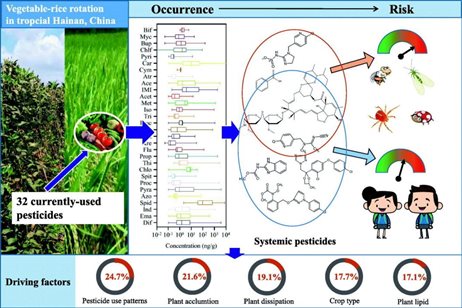Recently, the Agricultural Environment Research Office of the Environment and Plant Protection Research Institute of the Chinese Academy of Tropical Agricultural Sciences has made important progress in the research on the pollution characteristics, impact mechanism and risk assessment of pesticides in crops in rice vegetable rotation areas in tropical region, and reported for the first time that the widespread residues of common pesticides in crops will bring potential ecological and health risks to non target organisms.
Due to the high incidence of diseases, pests and weeds, the frequent use of multiple pesticides during rice and vegetable planting is widespread, which may pose a potential risk to non target organisms (such as bees, lacewings, ladybirds and humans), which makes an important knowledge gap in the risk assessment of organic pollution in hot areas. This study was the first to analyze the occurrence, temporal and spatial characteristics, driving factors and ecological/health risks of commonly used pesticides in crops in the rice vegetable rotation area of southern Hainan. The results showed that carbendazim, acetamiprid and pyrazolidate were the most commonly detected pesticides in crops; Pesticide residues in crops showed significant spatio-temporal distribution characteristics, and were closely related to pesticide use mode, crop type, plant accumulation/dissipation and lipid content; Risk quotient method reveals that the multi residues of pesticides in crops pose a potential medium ecological/health risk to non target organisms, and the risk pesticides mainly come from endogenous pesticides. This study provides a scientific basis for the selection of prevention and control objectives of pesticide non-point source pollution in hot areas.
This research achievement was published in Science of The Total Environment, a journal in the field of environmental science, under the title of "Occurrence, distribution, and driving factors of current use practices in commonly cultivated crops and their potential risks to non target organizations: A case study in Hainan, China". Tan Huadong, Assistant Researcher of the Environment and Plant Protection Research Institute of CATAS, is the first author of the paper, and Wu Chunyuan is the corresponding author. The research was supported by the National Natural Science Foundation of China, Hainan Natural Science Foundation and other programs, and the National Agricultural Environment Danzhou Observation and Experiment Station and other platforms.

Schematic diagram of pesticide residue characteristics, influencing factors and risk assessment in crops of rice vegetable rotation system


